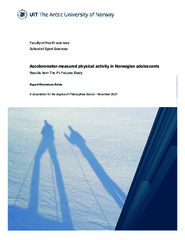| dc.description.abstract | This thesis examined the prevalence and patterns of accelerometer-measured physical activity in a cohort of urban-rural older adolescents in Northern Norway, participating in the Fit Futures Study. The thesis also assessed the validity of self-reported physical activity against accelerometer measurements, and explored the association between accelerometer-measured physical activity and subsequent change in five different measures of body composition over 2 years of follow-up. We found that less than 25 % of older adolescent boys and girls fulfilled the global physical activity recommendations. The self-reported physical activity questionnaire seems to be able to rank physical activity levels, and the validity is fairly stable across strata of sex, BMI, and education. However, the validity in providing information on absolute physical activity levels is limited. Minutes spent in baseline moderate-to-vigorous physical activity were not associated with subsequent changes in measures of body composition in neither sex. Sedentary time and light physical activity were associated with changes in lean body mass in girls, but not boys. The findings are interpreted in light of the substantial changes in habits and body composition that occur during adolescence. As few adolescents seem to adhere to the PA guidelines, there is a need for more research on how to promote and implement physical activity in a way that is tailored to adolescents. | en_US |
| dc.description.popularabstract | Physical activity is essential for health. National authorities recommend that children and adolescents accumulate on average at least 60 minutes of moderate-to-vigorous physical activity each day. This thesis examined the amount and patterns of physical activity among adolescents in high school participating in the Fit Futures Study, and further assessed how well self-reported physical activity levels reflect device-measured physical activity. Third, we studied the association between device-measured physical activity and subsequent change in body composition. We found that less than 25% of the participants fulfilled the recommendations and that boys were slightly more active than girls. The participants were able to classify themselves fairly correct into one of four categories of physical activity levels. In general, physical activity did not influence body composition. | en_US |
| dc.relation.haspart | <p>Paper I: Beldo, S.K., Morseth, B., Christoffersen, T., Halvorsen, P.A., Hansen, B.H., Furberg, A.S., Ekelund, U. & Horsch, A. (2020). Prevalence of accelerometer-measured physical activity in adolescents in Fit Futures - part of the Tromsø Study. <i>BMC Public Health, 20</i>(1), 1127. Also available in Munin at <a href=https://hdl.handle.net/10037/18925>https://hdl.handle.net/10037/18925</a>.
<p>Paper II: Beldo, S.K., Aars, N.A., Christoffersen, T., Furberg, A.S., Halvorsen, P.A., Hansen, B.H., … Morseth, B. Criterion validity of the Saltin-Grimby Physical Activity Level Scale in adolescents. The Fit Futures Study. (Submitted manuscript).
<p>Paper III: Aars, N.A., Beldo, S.K., Jacobsen, B.K., Horsch, A., Morseth, B., Emaus, N., Furberg, A.S. & Grimsgaard, S. (2020). Association between objectively measured physical activity and longitudinal changes in body composition in adolescents; The Tromsø Study Fit Futures Cohort. <i>BMJ Open, 10</i>(10), e036991. Also available in Munin at <a href=https://hdl.handle.net/10037/20037>https://hdl.handle.net/10037/20037</a>. | en_US |


 English
English norsk
norsk